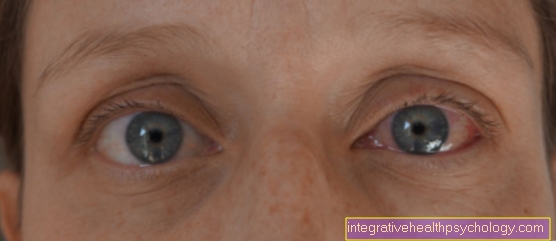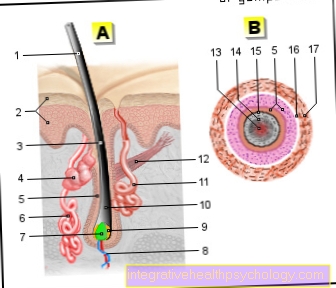Abscess in the nose
definition
An abscess is an encapsulated pus cavity that results from inflammatory tissue melting and is usually the result of a local, bacterial infection. Bacteria can enter the skin through a small lesion. These injuries often occur in the nose, e.g. after removing nasal hairs or manipulating the nose with your fingers.
The abscess must be differentiated from a boil, which also often arises in the nose. A boil is inflammation of a hair follicle.
In principle, an abscess has a good prognosis. However, if the pus occurs in the nose, special care is required, as germs can be carried into the brain, which is very dangerous. Therefore, a doctor should be consulted in good time.
Learn more about the topic: Abscess - cause, symptoms, therapy and prognosis

Causes of an Abscess in the Nose
In most cases, an abscess is caused by bacteria. The most common bacterium that causes abscesses is Staphylococcus aureus. This is very often found in the nose and generally colonizes human skin without necessarily triggering an illness.
In addition, other bacteria can lead to the formation of an abscess. The germs enter the skin through a small wound in the nose and trigger an inflammatory reaction there. Immune cells in the body migrate and try to fight the bacterium. In the course of this immune reaction, pus and tissue melt-downs develop, which lead to the pus cavity.
The nose in particular is an ideal place for bacteria. The nasal cavity is always slightly damp and warm - the perfect climate for the germs to multiply. In addition, tampering with the nose with a finger or detaching solid bark in the nose can easily lead to skin wounds that make it easier for bacteria to enter.
Bacteria can also penetrate along the roots of the nasal hair. Such an inflammation, which affects the hair follicle and the surrounding tissue, is called a boil. The only difference to the abscess is the relation to the hair follicle.
Read our main article at this point and learn more about the topic at: Pus in the nose
diagnosis
The diagnosis of the abscess in the nose can already be reliably made by the family doctor by the appearance of the change. The abscess is usually very sensitive to pain and appears swollen, red and overheated. If the abscess is so deep in the nose that the family doctor cannot assess it well, an ear, nose and throat doctor should be consulted.
It may be necessary to have a blood sample taken to check for signs of inflammation in the blood. If there is also a headache and there is a suspicion of dangerous spread of the bacteria into the brain, an imaging of the head, e.g. an MRI or CT scan.
Symptoms of an abscess in the nose
The symptoms of an abscess in the nose are primarily characterized by the inflammatory reaction. This means that the abscess is primarily perceived by the person concerned because of the pronounced pain. This pain is particularly acute when pressure is applied to the nose.
In addition, the pus cavity leads to a significant swelling, which also tightens the skin above the abscess and therefore leads to a feeling of tension. Furthermore, the skin over the abscess appears redder and warmer than the surrounding skin.
Since complications can occur with any abscess, the following warning symptoms should be observed:
- fever
- Headache
- New epileptic seizures
A fever is an indication that the infection has spread throughout the body and dangerous blood poisoning can occur that must be treated by a doctor.
Headaches and epileptic seizures, on the other hand, are warning symptoms, especially with an abscess in the nose. These symptoms can indicate that the bacterium has already spread to the brain and, for example, a thrombosis of the cerebral vessels has occurred. This complication, if identified early, is usually well treatable but should be taken seriously.
Any warning symptom should mean that a doctor is consulted immediately within the shortest possible time.
Treatment of an abscess in the nose
There are several building blocks to treating the abscess in the nose.
In the case of small, less inflamed abscesses, it may be sufficient to use pull ointment to help the abscess heal more quickly. Larger abscesses, on the other hand, should be surgically removed by the doctor. This also reduces the likelihood of the abscess recurring in the nose, as the doctor will remove the entire cavity.
Care should be taken to take good care of the wound after the procedure. It should be rinsed daily with a disinfectant compatible with the mucous membrane until it has healed and only touched with clean hands. In this way, wound infection can be avoided. It may also be necessary to take an antibiotic to fight the bacteria that remain in the skin. Both tablets and an ointment containing antibiotics can be used for this. It is best for the attending physician to decide whether both are necessary.
It is important that an abscess should never be treated and expressed by the person affected, as this can lead to life-threatening complications. This particularly affects abscesses in the nose. A doctor should therefore always be consulted.
Find out more here: Surgery of an abscess
When do I need an antibiotic?
The question of whether and when an antibiotic is necessary can best be decided individually by the doctor who examined the abscess. The decisive factor here is how big the abscess is and how inflammatory the surrounding tissue appears. In any case, a large abscess that is severely inflamed should be treated immediately with antibiotics.
Since the nose is a particularly dangerous place with regard to the spread of germs, the doctor will generally resort to an antibiotic at an early stage.
Even if the doctor has surgically removed the abscess, it is important to continue therapy with an antibiotic.
Personal factors also play a role. This means that people with compromised immune systems are more likely to be prescribed an antibiotic. This includes people with a congenital immune deficiency, but also people who have to take an immune-weakening drug due to an organ transplant or people infected with HIV. Diabetics also have a slightly weakened immune system.
Pull ointment against abscesses
Pull ointment can be used to treat early abscesses as it helps the pus bladder to mature more quickly and soften the skin over the lesion, making it easier for the pus to leak out. In addition, the sulfonated shale oil contained in the draft ointment is said to have an anti-inflammatory effect. In addition, the sulfonated shale oil also helps to relieve pain and promote blood circulation.
However, since it is essential to rule out the possibility of bacteria spreading to the brain in the area of the nose, treatment is rarely done with pulling ointment alone. In this case, antibiotic therapy is more important.
Home remedies for abscesses in the nose
An abscess in the nose is a serious infection that should definitely be seen by a doctor to avoid possible complications. Still, there are a few home remedies that can generally help the abscess to heal.
For one thing, warm compresses help the abscess to mature. Exposure to red light can also help relieve symptoms. Furthermore, ointments with essential oils or forest ragweed can have a disinfecting and ripening effect. However, it is important to ensure that the essential oils are not well tolerated by all people. Any treatment with home remedies should be discussed with the doctor to avoid complications.
More information can be found here: Home remedies for an abscess
Should you express the abscess yourself?
In general, abscesses should never be expressed yourself! The undirected pressure can lead to the pus cavity including the germs emptying inwards. This can cause the inflammation to spread or even get the bacteria into the bloodstream, causing life-threatening blood poisoning.
On the nose, it is particularly important that abscesses should not be expressed themselves, as the inflammation can spread from the face to the brain and thus become life-threatening.
You might also be interested in: Healing An Abscess - This Is What To Look For
Ointment for an abscess in the nose
In addition to the pull ointment, other ointments can also be used to treat the abscess in the nose. While the draft ointment primarily supports the maturation of the abscess, ointments containing antibiotics can prevent the inflammation from spreading. An ointment with a so-called tetracycline antibiotic is often used for this.
However, since the spread of bacteria from the nose into the brain is particularly dangerous, the antibiotic ointment is usually not enough and is supported by an antibiotic that is swallowed in tablet form or brought into the body's circulation via the vein.
You can find more on the topic here: Treat abscesses with ointments
Duration of the abscess
The duration of treatment for an abscess depends largely on how large the abscess is and whether it is easily accessible.
A small abscess can possibly heal completely within one to two weeks with the help of pulling ointment alone. A larger abscess, on the other hand, must always be removed by the doctor. The resulting wound then has to heal slowly. It is important to always keep the wound clean and, if possible, to clean it with a disinfectant for the mucous membrane, as infection of the wound significantly increases the time it takes for the wound to heal and also leads to complications.
An abscess in the nose is generally a little more difficult to treat than on the trunk of the body, as you have to be particularly careful not to spread germs into the brain. Therefore, it is also important to take a prescribed antibiotic for exactly as long as the doctor prescribed, even after the symptoms have subsided.
Even if the wound healing takes some time after the surgical removal of the abscess, this type of therapy is always recommended, as it can significantly reduce the likelihood that an abscess will occur again at this point.
How dangerous is an abscess in the nose?
In principle, an abscess is not dangerous and, if treated correctly, heals quickly and without consequences. However, the pus cavity becomes dangerous when the bacteria spread to the brain via the blood vessels. In this case, the blood vessels that collect and drain blood from the brain can thrombose. This is known as sinus vein thrombosis.
Since the blood cannot flow out of the brain as usual in this case, the congestion can lead to bleeding in the brain. A warning sign is a new headache or epileptic seizure. Sinus vein thrombosis can usually be treated well if it is recognized in good time. However, there are also severe courses that can lead to death. Therefore, extreme caution should be exercised with an abscess in the area of the nose. The abscess should always be treated hygienically and a doctor should be consulted for therapy.







.jpg)






.jpg)














